Hanzi vs Kanji // Japanese Kanji NOT To Use in Chinese
Hanzi vs Kanji // Characters You Shouldn’t Confuse
Today we talk about two scripts that appear the same, but things aren’t always as they seem. We are referring to Hanzi vs Kanji, the beautiful scripts of Mandarin Chinese and Japanese.

Both Japanese and Chinese have a long history of sharing characters with each other, but somewhere along the way a few Japanese kanji have come to have completely different (even obscene) meanings when used in Chinese.
When you learn Japanese, or Chinese, you’ll notice that there is a key crossover with Hanzi and Kanji.
Let’s take 年 for example.
This means year in both Chinese (nian) and Japanese (toshi). Two for the price of one. Excellent!
You’ll come to realise some parts of a Japanese sentence read/mean almost the same as Mandarin Chinese – and whilst this is a big help, that doesn’t mean every character you see has the same meaning in both Japanese and Chinese.
And that is exactly where the inspiration for this article has come from!
Watch out for these kanji that might get you in trouble.
Hanzi vs Kanji – 素敌 vs 素敵
Hanzi vs Kanji – 我 & 我々
Hanzi vs Kanji – 我慢
Hanzi vs Kanji – 怪我
Hanzi vs Kanji – 邪魔
Hanzi vs Kanji – 日本人
Hanzi vs Kanji – FAQ’s
Hanzi vs Kanji #1 // 素敌 vs 素敵
| Chinese (Hanzi) | Japanese (Kanji) |
|---|---|
| 素敌 | 素敵 (すてき) |
| sù dí | suteki |
| Enemy Features 👿 | Lovely, wonderful, beautiful, attractive |
Apparently enemy elements are attractive?

In Japanese ‘suteki’ is used as a complement, like when something wonderful happens!
Chinese however is a different story… when Chinese see 素敌, they understand it as:
- 元素 yuán sù | element, feature
- 敌人 dí rén | enemy
So the implied meaning ends up becoming the features of an enemy!
Maybe that would give the image of horns or a death stare?
Certainly not the way you would want to describe something!
A way to say ‘suteki’ in Chinese would be with words like
- 漂亮 piāo liàng | beautiful
- 美丽 měi lì | lovely
- 很好 hěn hǎo | great, well done
Let’s try not to tell someone they have the elements of an enemy when trying to complement them!

How To Learn Kanji // 7 Tips for Success 💪
How to learn Kanji? Generally, you’ll need to learn about 1,000-2,000 Chinese characters in Japanese. Here’s the best way to go about learning them.
Hanzi vs Kanji #2 // 我 & 我々
| Chinese (Hanzi) | Japanese (Kanji) |
|---|---|
| 我 ? | 我々 (われわれ) |
| wǒ ? | wareware |
| Me/I… | We |
What did we or me do?
Japanese uses 々 to represent a repeated kanji and make things plural.
- 日々 (ひび) hibi | days, or every day
- 星々 (ほしぼし) hoshiboshi | stars
- 時々 (ときどき) tokidoki | occasionally, every once in a while
It’s very useful and saves time when writing kanji out by hand!
‘Wareware’ is used more by guys when referencing themselves with a powerful group as ‘we’, but it’s not often used in daily conversation, unless you’re in Naruto (see below).
However, Chinese doesn’t even have 々! There’s no pinyin for it and it won’t even show up in Pleco!
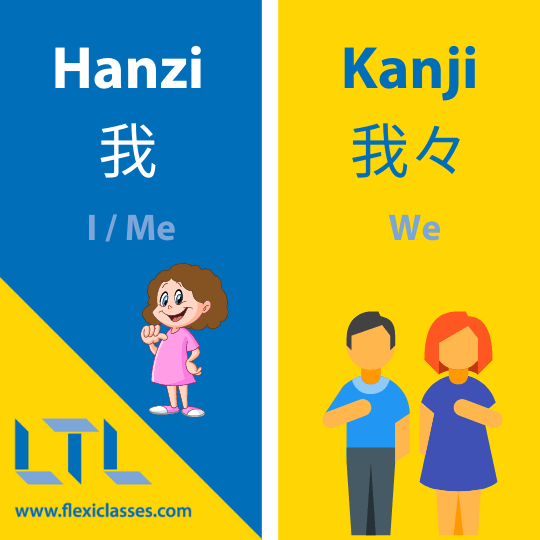
When there’s a character repeated, Chinese does all the work of writing out the full character instead of taking a shortcut:
- 天天 tiān tiān | every day
- 星星 xīng xīng | star
- 常常 cháng cháng | often, frequently
However, in the case of ‘wareware’, Chinese doesn’t just repeat ‘wǒ’ to make it plural. 我我 would just mean ‘me me’, not much sense there.
As there’s no 々, the way to say the plural ‘we’ in Chinese would be
- 我们 wǒ men = we, us
- The 们 (men) makes the subject plural.
Just know that ‘wǒ men’ doesn’t carry the same powerful manly Naruto vibes that ‘wareware’ does!
Hanzi vs Kanji #3 // 我慢
| Chinese (Hanzi) | Japanese (Kanji) |
|---|---|
| 我慢 | 我慢 (がまん) |
| wǒ màn | gaman |
| I’m slow | Patience, endurance, self-restraint |
The path to patience, is a slow one, apparently.
‘Gaman’ is a very important concept in Japanese culture. To push yourself through hard times or to hold on just a bit longer.
This national virtue of ‘gaman’ helps Japanese to persevere and tolerate unexpected difficulties (just don’t push yourself too hard).
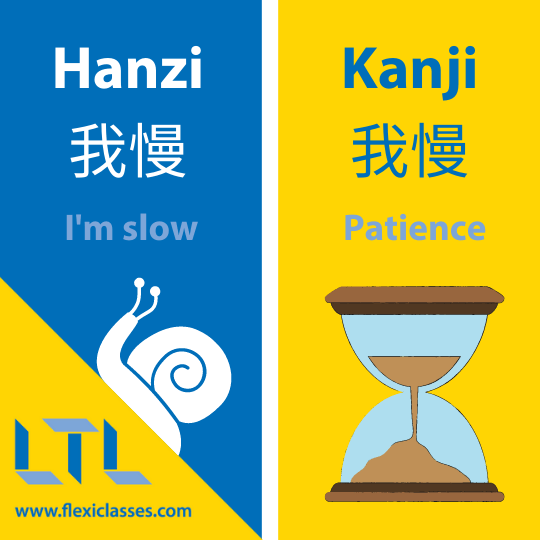
However, the kanji translated directly to Chinese completely loses its meaning, the honourable concept just ends up interpreted as ‘I’m slow’.
Most likely being slow is not seen as a national virtue.
A way to say ‘gaman’ in Chinese would be
- 忍 rěn | endure, put up with, to restrain oneself
FUN FACT – ‘忍’ in Japanese is actually used for 忍者 (にんじゃ) which is pronouced as the word we all know and love…ninja!!
Hanzi vs Kanji #4 // 怪我
| Chinese (Hanzi) | Japanese (Kanji) |
|---|---|
| 怪我 | 怪我 (けが) |
| guài wǒ | kega |
| Blame me | Injury |
Well at least we know who to blame for the injury…
‘Kega’ in Japanese describes an accidental error or ‘injury’ and can be written in hiragana, katakana or in kanji.
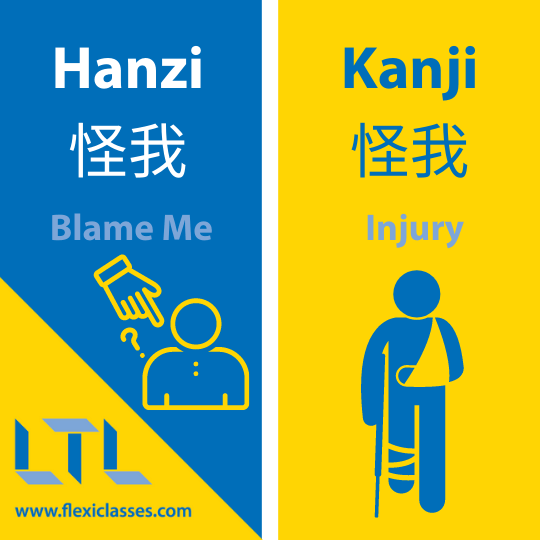
The kanji for the word are used phonetically to represent the sounds ‘け’ and ‘が’ instead of for the kanji’s actual meaning (kanji used phonetically are known as 当て字 ateji).
Using Japanese kanji phonetically can make for some pretty interesting Chinese interpretations… thus ‘injury’ becomes ‘blame me’.
‘Guài wǒ’ is used in Chinese when you’re telling someone to put the blame on yourself and is used commonly in sad break up songs.
Take this one for example – Andy Lau 刘德华 – 都怪我
However on the internet it’s used sarcastically as a slang ‘怪我咯’ with the nuance of ‘but can you blame me?’
See a popular example here.
Taking the blame is quite different than saying you have an injury, so try not to mix these meanings up!
The way to say ‘kega’ in Chinese is:
- 伤 shāng | injury


Hanzi vs Kanji #5 // 邪魔
| Chinese (Hanzi) | Japanese (Kanji) |
|---|---|
| 邪魔 | 邪魔 (じゃま) |
| xié mó | jyama |
| Evil demon | Hinderance, nuisance, disturbance, interference |
Because only evil demons would dare to be a nuisance? So harsh!
In Japanese, the severity of ‘jyama’ is based on context, but it is used in a common set phrase for entering someone’s house
お邪魔します (おじゃまします) ojamashimasu
Excuse me for disturbing, thanks for having me
Hopefully you’re not actually hindering your friend, but this is said out of respect to the owner of the house you’re entering.
However in Chinese, there’s no range of severity, it directly gives the horrid image of an evil demon!
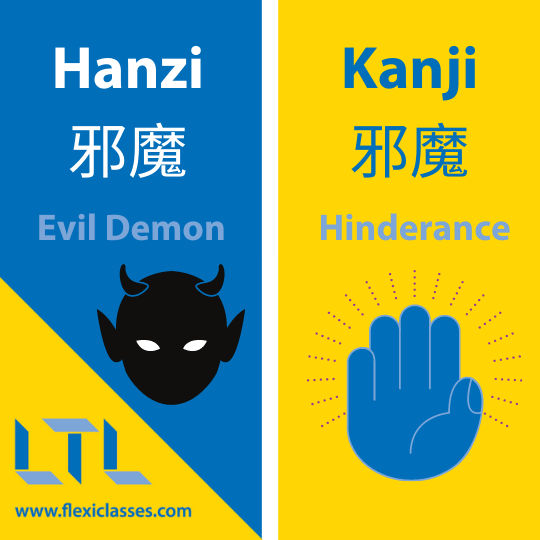
Chinese read ‘xié mó’ as:
- 邪恶 xié è | evil, sinister, wicked
- 魔鬼 mó guǐ | devil, demon, monster
Even if someone is being a slight nuisance, you wouldn’t want to straight up call them an evil demon (right?), so please be careful with this one!
A way to say ‘jyama’ in Chinese is
- 打扰 dǎ rǎo | disturb, trouble, bother, interrupt
Hanzi vs Kanji #6 // 日本人
| Chinese (Hanzi) | Japanese (Kanji) |
|---|---|
| 日本人 | 日本人 |
| rì běn rén | nihonjin |
| Japanese person/Screw myself | Japanese person |
Well that escalated quickly…
Emphasis is everything!
Putting emphasis on rì běn-rén means Japanese Person, buuuut emphasis on rì-běn rén changes everything.
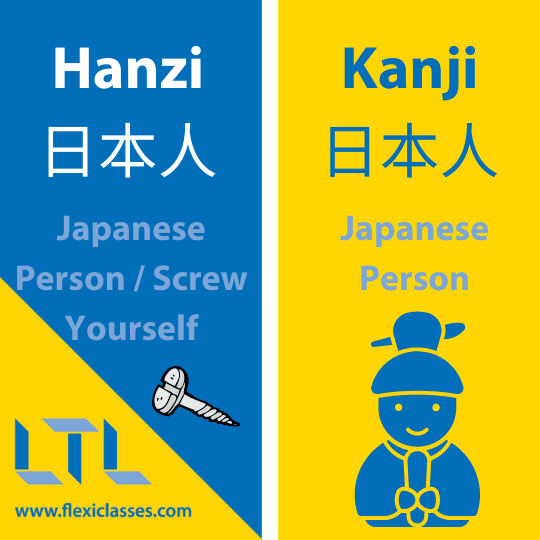
- 日 rì | (in southwest Chinese dialects) screw
- 本人 běn rén | oneself
This way of using ‘rì’ comes from different Chinese dialects and has been circulating long before its use on the internet.
‘Běn’ can describe origin, source or roots.
- 本来 běn lái | Originally, at first
- 本能 běn néng | instinct, original ability
- 本身 běn shēn | itself, per se
- 本国 běn guó | one’s own country
It’s all just an unfortunate linguistic coincidence that could have been prevented if Japan had kept their previous name!
- Japanese >>> 大和 (やもと) yamoto | Ancient name for Japan
- Chinese >>> 大和 dà hé | Great harmony
But they decided to change to ‘nippon’ instead during the Heian period, and here we are now.
FUN FACT – 日本 first got it’s Japanese pronunciation from Toisan Cantonese ‘nippon’!
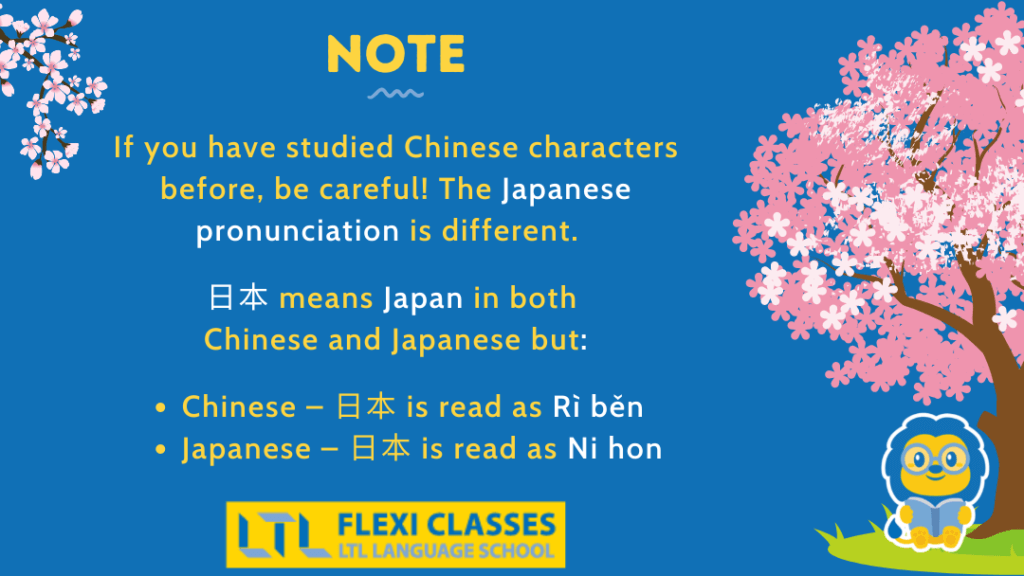
I personally studied Japanese before starting Chinese and remember the awkward misunderstandings when kanji didn’t translate over like intended…
Good learning experience!
I hope these kanji explanations help you on your own language learning journey as you dive into the worlds of Japanese and Chinese!
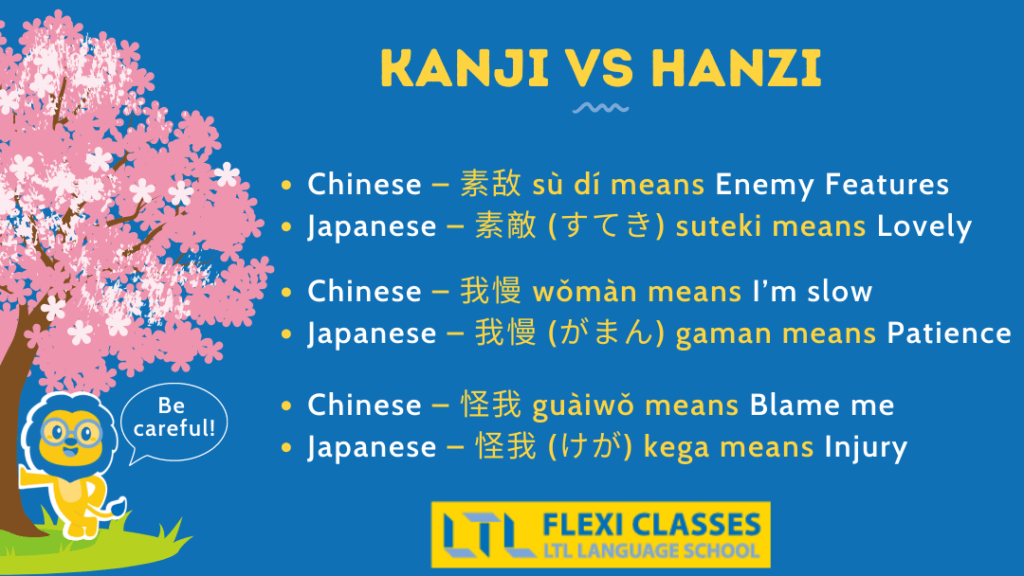
Do you know anymore examples? Why not drop us a comment below and tell us!
Hanzi vs Kanji // FAQ’s
Do Chinese Hanzi and Japanese Kanji always have the same meaning?
No and this is important to know because many do – but not all!
When you learn Japanese, or Chinese, you’ll notice that there is a key crossover with Hanzi and Kanji.
Let’s take 年 for example.
This means year in both Chinese (nian) and Japanese (toshi). Two for the price of one. Excellent!
You’ll come to realise some parts of a Japanese sentence read almost the same as Mandarin Chinese – and whilst this is a big help, that doesn’t mean every character you see has the same meaning in both Japanese and Chinese.
Does 々 exist in Chinese Hanzi?
No it doesn’t.
Japanese uses 々 to represent a repeated kanji and make things plural.
In Chinese you simply write the same Hanzi again. Some examples:
天天 tiān tiān | every day
星星 xīng xīng | star
常常 cháng cháng | often, frequently
What does 邪魔 mean in Chinese and Japanese?
These have two very different meanings in each language and it’s important to note the differences if you study both Chinese & Japanese!
邪魔 in Chinese means evil demon!
Whereas 邪魔 in Japanese means hinderance, nuisance, disturbance or interference.
Does 日本人 mean “Japanese people” in Chinese?
Yes but there’s an alternate meaning also!
Emphasis is everything!
Putting emphasis on rì běn-rén means Japanese Person, buuuut emphasis on rì-běn rén changes everything.
日 rì | (in southwest Chinese dialects) screw
本人 běn rén | oneself
This way of using ‘rì’ comes from different Chinese dialects and has been circulating long before its use on the internet.
Want More From LTL?
WANT TO LEARN JAPANESE? Check out our online Japanese courses here.
We offer a 7-day free trial to all new students where you can study 24/7.
What about studying Japanese in Japan instead? We’ve got your back. Our Japanese courses in Tokyo can either be taken in small groups of no more than 5 students or individually for a more tailored experience.
We even offer incredible homestay experiences in Tokyo as well.
Come and be a part of this amazing community.














2 comments
This is such a good guide for someone like me who knows Chinese well but is starting Japanese. Genuinely crazy how different they can be!!
Really glad you liked it Stephanie. Sarah has a wealth of knowledge between the two languages which we love having on the website for students like yourself!